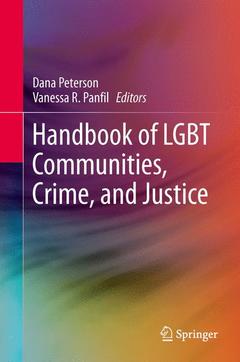Description
Handbook of LGBT Communities, Crime, and Justice, 2014
Coordinators: Peterson Dana, Panfil Vanessa R.
Language: English
Subjects for Handbook of LGBT Communities, Crime, and Justice:
Publication date: 07-2014
587 p. · 15.5x23.5 cm · Paperback
Publication date: 12-2013
587 p. · 15.5x23.5 cm · Hardback
Description
/li>Contents
/li>Biography
/li>Comment
/li>
Vanessa R. Panfil received her Ph.D. in Criminal Justice from the University at Albany and is currently a post-doctoral associate in the School of Criminal Justice at Rutgers University (Newark, NJ). Her research explores how gender and sexuality shape individuals’ experiences with gangs, crime, victimization, and the criminal and juvenile justice systems. For her dissertation, she designed and conducted a partially ethnographic, in-depth interview study of self-identified gay gang members, in order to analyze the complex relationships between the commission of crime and/or gang membership and the construction of gay andmasculine identiti




